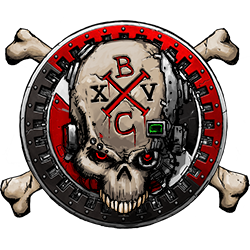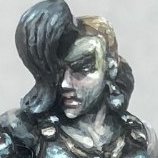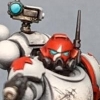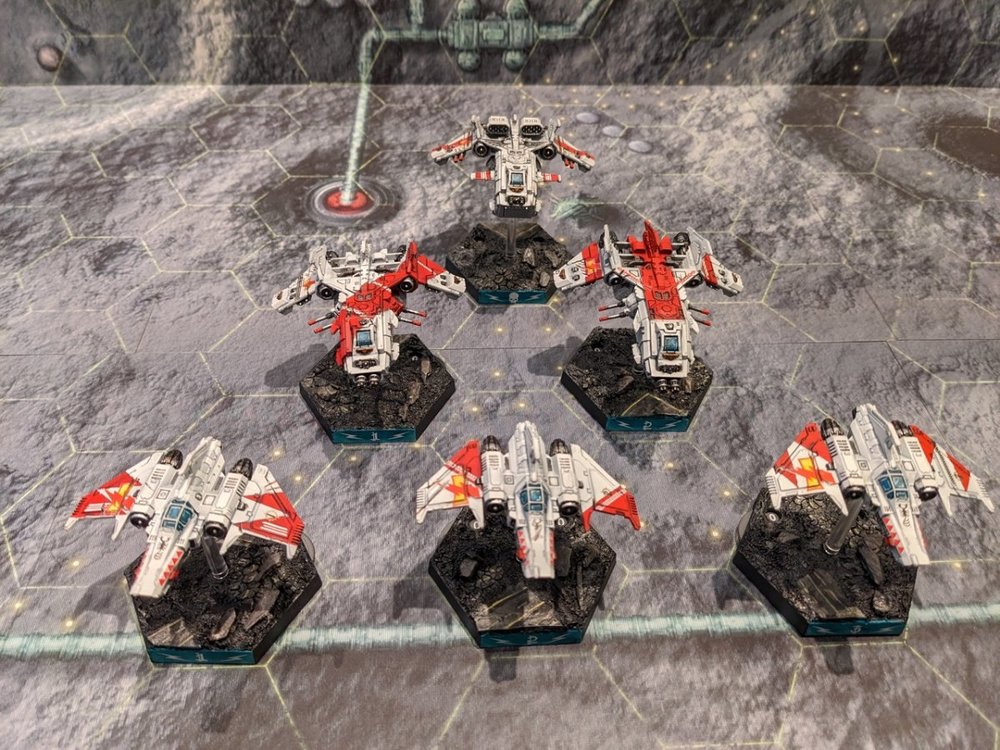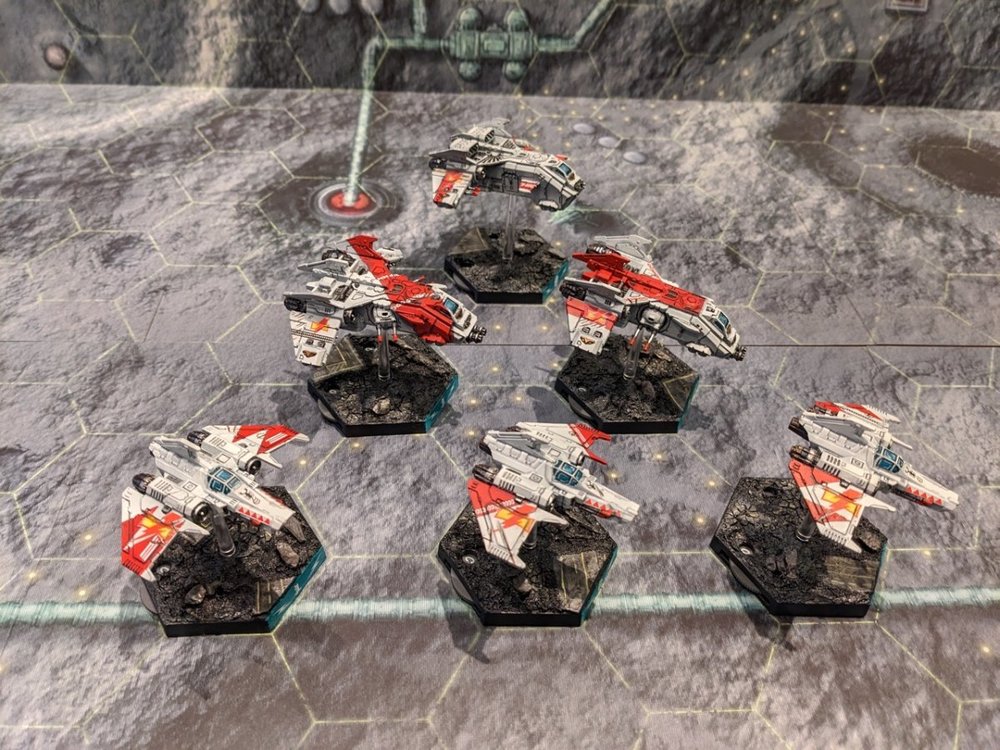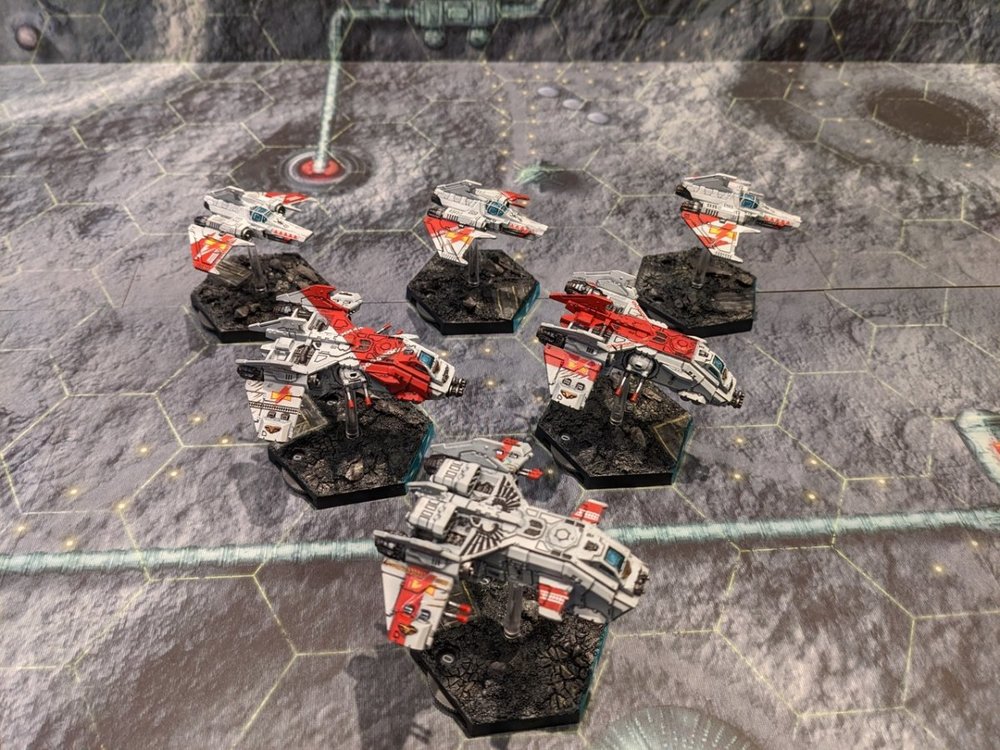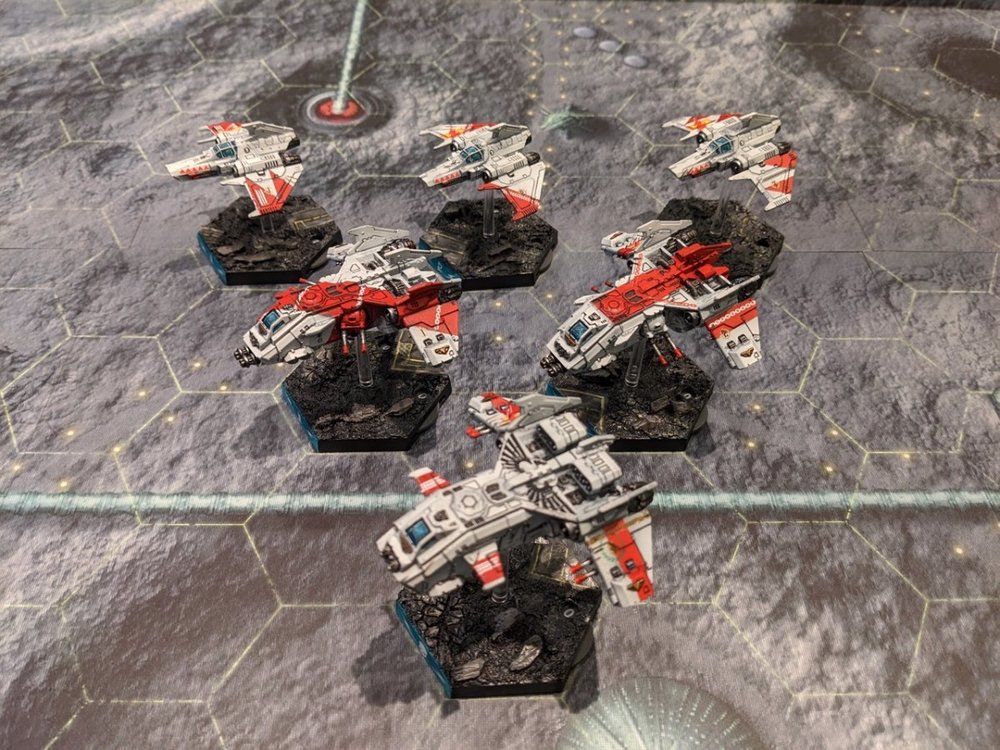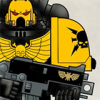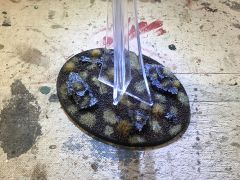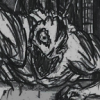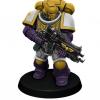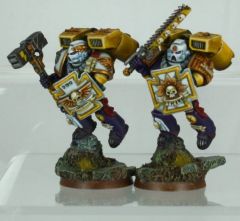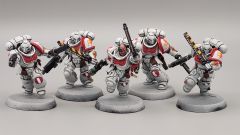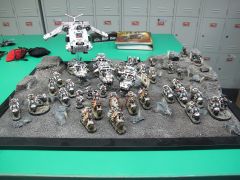Search the Community
Showing results for tags 'White Scars'.
-
My place for all things Space Marine! I have started to built a small force for the Horus Heresy, after having abandoned Space Marines for almost a decade now. The Nuncio Vox in the new MK6 kit looks too 40k in my eyes , so I have built my own version, for my two tactical squads.
- 76 replies
-
- Horus Heresy
- White Scars
- (and 6 more)
-
I've just completed my first White Scars Squadron and thought I'd share some pictures with you guys. These are some of my favourite GW models for a long time and they're an absolute joy to paint up. Rik
- 12 replies
-
- painting
- Aeronautica
-
(and 1 more)
Tagged with:
-
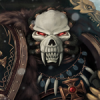
Falcon's Claws Ebon Keshig
Algrim Whitefang posted a gallery image in Adeptus Astartes / Legiones Astartes
From the album: White Scars Homebrew Chapters
Pictured Above: Falcon's Claws Ebon Keshig Vu-Jaikhar, 'Steadfast Champion of the Stormwrath Bastion', of the elite 1st Zuun ('Brotherhood of the Untamed Stallion'), arrayed in relic Cataphractii pattern Tactical Dreadnought Armour.© Algrim Whitefang
-
- Cataphractii
- Cataphractii Pattern
- (and 10 more)
-
From the album: Armament81's Destroyers
First and most important piece of the Storm Talon completed.© Armament81
-
- Storm Talon
- Destroyers
-
(and 2 more)
Tagged with:
-
From the album: Armament81's Destroyers
Got 4 more finished and they are preped to have their chapter symbol decals put on.© Armament81
-
- Destroyers
- White Scars
-
(and 2 more)
Tagged with:
-
From the album: Aldurukh archive
Jaghatai Khan, The Warhawk of Chogoris, The Great Khan, and The Horseman. Primarch of the V legion, White Scars. -
From the album: Stormbrothers by geektom
-

Falcon's Claws Khaishan Noyan-Khan
Algrim Whitefang posted a gallery image in Adeptus Astartes / Legiones Astartes
From the album: White Scars Homebrew Chapters
Pictured Above: Khaishan Noyan-Khan, current Chapter Master of the Falcon's Claws. Current Chapter Master of the Falcon's Claws, Khaishan Noyan-Khan is a fearsome and stalwart warrior without peer. He was taken from a backwater feral world where he grew up riding wild horses on the planet's grass plains hunting wolves and other apex predators. Having mastered the art of the hunt at a young age he would later bring his skills to bear as a newly inducted Neophyte of the Falcon's Claws. He quickly rose through the Chapter's ranks, taking to the field of battle like a force of nature, with fury and strength behind his aggression that, while appearing barbaric, was tempered by his keen intelligence and innate understanding of the ebb and flow of the battle. A highly active commander, Khaishan leads his warriors from the front, issuing commands with relentless assurance, and assisting his Khans in breaking the most troublesome enemy defences. A keen and intelligent commander, the Noyan-Khan welcomes his subordinates to call into question his decisions should they ever doubt their effectiveness. In this way, he remains humble, reminding himself of their gene-sire's willingness to learn, for no one was above learning from their mistakes or being corrected if they were in error. This also ensures that his warriors never became followers of blind faith.© Algrim Whitefang
-
- Chapter Master
- Custom Art
- (and 10 more)
-

Falcon's Claws Kharash Tartaros Terminator
Algrim Whitefang posted a gallery image in Adeptus Astartes / Legiones Astartes
From the album: White Scars Homebrew Chapters
Pictured Above: Falcon's Claws Kharash Terminator To'bas Sudolgor, 'Agile Blademaster of the Legendary Tempest', of the 5th Zuun ('Wolf Maw Brotherhood') arrayed in relic Tartaros pattern Terminator Armour and armed with an artificer Guan Dao (Power Lance).© Algrim Whitefang
-
- Custom Art
- Custom Character
- (and 12 more)
-

Falcon's Claws Assault Marine
Algrim Whitefang posted a gallery image in Adeptus Astartes / Legiones Astartes
From the album: White Scars Homebrew Chapters
Pictured Above: Falcon's Claws Nokud Jurgei Chogan of the 3rd Zuun ('Stormlord Brotherhood'), unknown Close Support Squad.© Algrim Whitefang
-
- Custom Art
- Custom Character
- (and 11 more)
-

Falcon's Claws Battleline Mk IV
Algrim Whitefang posted a gallery image in Adeptus Astartes / Legiones Astartes
From the album: White Scars Homebrew Chapters
Pictured Above: Falcon's Claws Nokud ('Warrior') Qai Fong of the 4th Zuun ("Brotherhood of the Black Falcon"), 2nd Arban (Battline Squad).© Algrim Whitefang
-
- Custom Art
- Custom Character
- (and 12 more)
-

Falcon's Claws Primaris Eradicator
Algrim Whitefang posted a gallery image in Adeptus Astartes / Legiones Astartes
From the album: White Scars Homebrew Chapters
Pictured Above: Falcon's Claws Primaris Eradicator Khajah Far, 'Heretic Slayer of the Thunderscar Stronghold', assigned to the 9th Zuun ('Highriders Brotherhood'), 15th Arban (Fire Support Squad).© Algrim Whitefang
-
- Custom Art
- Custom Character
- (and 9 more)
-

Falcon's Claws Primaris Assault Intercessor
Algrim Whitefang posted a gallery image in Adeptus Astartes / Legiones Astartes
From the album: White Scars Homebrew Chapters
Pictured Above: Newly assigned Falcon's Claws Primaris Assault Intercessor Xebe-Nogat of the 2nd Zuun ('Eagle Eyes Brotherhood'), 12th Arban (Close Support Squad).© Algrim Whitefang
-
- Custom Art
- Custom Character
- (and 9 more)
-

Falcon's Claws Primaris Reiver
Algrim Whitefang posted a gallery image in Adeptus Astartes / Legiones Astartes
From the album: White Scars Homebrew Chapters
Pictured Above: Falcon's Claws Primaris Reiver Angnat Sarat, 'Hawkeyed Tracker of the Alabaster Vigil', 9th Zuun ('Highriders Brotherhood'), 4th Arban (Scout Squad).© Algrim Whitefang
-
- Custom Art
- Custom Character
- (and 9 more)
-

Falcon's Claws Tulpar Grav Bike
Algrim Whitefang posted a gallery image in Adeptus Astartes / Legiones Astartes
From the album: White Scars Homebrew Chapters
Falcon's Claws Nokud Vai Ghong, 'Stalwart Bloodrider of the Windstorm Spearhead', 3rd Zuun ('Stormlord Brotherhood'), 4th Arban (Battleline Squad), piloting the relic Tulpar Pattern Grav Bike Shadow Strike.© Algrim Whitefang
-
- Custom Art
- Custom Image
- (and 8 more)
-

Falcon's Claws Relic Land Speeder
Algrim Whitefang posted a gallery image in Adeptus Astartes / Legiones Astartes
From the album: White Scars Homebrew Chapters
Pictured Above: A pair of Falcon's Claws Nokud of the 8th Zuun ('Brotherhood of the Bloody Axe'), 7th Arband (Aerial Squadron) piloting the archaic Land Speeder, Swift Wind. This ancient Chapter makes use of many such ancient wonders from the Dark Age of Technology.© Algrim Whitefang
-
- Custom Art
- Custom Images
- (and 8 more)
-

Desert Hawks Armorial
Algrim Whitefang posted a gallery image in Adeptus Astartes / Legiones Astartes
From the album: White Scars Homebrew Chapters
The Desert Hawks are a loyalist non Codex-compliant Successor Chapter created from the lineage of the ancient and heroic White Scars during the 8th Founding. It's a small and endangered Chapter with only three ordinary companies left after the Soul War - a hard won victory almost 300 years ago against the Chaos Lord Haman Mal of Tzeentch and his daemons. This victory nearly destroyed the Chapter. Read More:© Algrim Whitefang
-

Celestial Heralds_Armorial
Algrim Whitefang posted a gallery image in Adeptus Astartes / Legiones Astartes
From the album: White Scars Homebrew Chapters
The Celestial Heralds are a Loyalist Successor Space Marine Chapter created during the 15th Founding from the proud and noble lineage of the White Scars. The history and character of the Celestial Heralds is inseparable from the sub-sector they call home and have defended for the past five millennia. The Huaguo Sub-Sector has a long and proud history of culture and productivity under the Imperium of Man. Though obscured by warp storms for an extended period, when they made their first contact in a centuries following the opening of the Cicatrix Maledictum, Terra came to realize that Huaguo sub-sector was reeling from blows it may never be able to recover from. Rebellious elements of every stripe have begun to pick apart the once peaceful region, with one having been so successful they even forced the sub-sector's Great Purity government into signing a treaty handing over worlds and establishing heretical embassies on loyalist planets. The Tau empire has taken advantage of the sub-sector's weakness to employ both trickery and violence in taking a whole swathe of northern mining worlds and are now worryingly close to the capitol hiveworld, Jingxing. But worst of all is the decadent decay that has struck at the very highest levels of the sub-sector. The civilian government is run by a group known as the Eunuchs, once able administrators who have now devolved into almost comically nepotistic and corrupt bureaucrats. Compounding the issue, the chapter master of the Celestial Heralds is deeply involved with these Eunuchs and through personal loyalty, political blindness, and a complete loss of touch with the situation in his old age, has allowed his control of the situation to completely deteriorate. Reinforcements and Primaris Space Marine upgrades were sent to the sub-sector as soon as contact was made, but further assistance has since been put on hold. It is as yet unclear whether the Huaguo Sub-Sector should be considered fully loyal, or if measures should be implemented. The High Lords of Terra have placed the matter on their docket for consideration with high priority, and we expect a decree on the topic in only a few more centuries. Read More: Celestial Heralds© Algrim Whitefang
-

Celestial Heralds Primaris Intercessor
Algrim Whitefang posted a gallery image in Adeptus Astartes / Legiones Astartes
From the album: White Scars Homebrew Chapters
Pictured Above: Celestial Heralds Primaris Intercessor of the 4th Company, 6th Battleline Squad.© Algrim Whitefang
-
- Custom Art
- Custom Images
- (and 11 more)
-
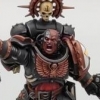
Indomitus Assault Intercessors Squad #1
EmpiricalReed posted a gallery image in White Scars & Successors
From the album: White Scars
Indomitus Assault Intercessors Squad #1-
- White Scars
- space marines
-
(and 1 more)
Tagged with:
-
Origins “Following him is a lesson in futility. His is a war fought on an entirely different level, too fast for the likes of us to participate. But that is fine. He leaves more than enough behind him for the rest of us.” –- attrib. Batukhan The known history of the Guardians begins sometime in the 33rd Millennium, when the Chapter was ordered to the Midas Cluster, far to the Galactic North. This is not, however, when the Chapter was Founded, though very few scraps of information remain from the period before their coming to the Midas Cluster. What little is known of this fuzzy period in the Guardians' past is that the Inquisition had a heightened awareness of the Chapter, with Inquisitorial agents and decrees a constant presence in the initial centuries of the Guardians' arrival. Many in the Chapter look toward their genetic flaw with progenoid gland production as the cause for their paranoid attentions. What little remains of the Guardians' existence prior to the 33rd Millennium are vague, providing little facts. Fragment writings attributed to what is believed to be one Batukhan, the Guardians' potential founding Chapter Master, detail his rise to command a Brotherhood of the White Scars Legion prior to the formation of Chapters, making the Guardians a potential 2nd or 3rd Founding. Whatever the history of the Chapter in that mythical age, the Midas Cluster proved a powerful influence, virtually recreating the Guardians in its image. The Midas Cluster had resisted the scouting forces of the Imperium at the tail end of the Great Crusade. With the horrific aftermath of the Heresy, the Imperium's attention turned inward. For millennia, the Midas Cluster had remained aloof, distant from the greater Imperium. Tasked by the Inquisition, the Guardians were sent wholesale into the Midas Cluster to take it for the Imperium. Though the fleet-based Chapter was a power unto themselves, capable of toppling whole worlds with the boom of their guns and the tread of their boots, the Midas Cluster resisted them at every turn. Wild xeno of breeds unknown, worlds and dangers missed or overlooked by ancient Imperial cartographers, and small bands of human colonies that wanted little to do with the Imperium. The Midas Cluster was rife with them and it proved a heady challenge the Guardians came close to failing. The battle that would have ended the Guardians' struggles was in the Archaegosian System, in orbit over its large, arid third world, whose derelict hives harbored a small but self-sustaining human population. The Eldar, whose presence in the Cluster had been a thorn in the Guardians' side, committed themselves to battle fully against the Chapter fleet. Their Craftworld, formidable in spite of its smaller size to some of the more well-known Craftworlds that have plagued the Imperium, entered the foray itself, turning a pitched battle into what nearly became an open rout. Though the Chapter lost a majority of its ships, it was their habit of taking considerable risks that ended up saving the Chapter. Rather than retreating, or burning alongside their own ships, the Guardians launched a full boarding assault against the Craftworld. Though the death toll was high for Marine and Eldar alike, the frantic battle concluded with the Craftworld's burning plummet onto Archaegos Tertiary. Though in considerably poor shape, the Guardians succeeded in breaking the backs of their greatest enemy within the Midas Cluster, allowing them time to recuperate their losses and consolidate their winnings within the Cluster. Some in the Chapter believe that the proliferation of their flaw began in this period, when the Chapter took chances with their recruitment programs to rebuild lost Companies. Though the continuing conquest of the Midas Cluster continued at a slower pace, it was declared secured in the Emperor's name four centuries after their arrival. However, the Midas Cluster has never been made truly compliant, and the Guardians, now the Guardians of Midas, have dedicated their efforts for millennia to holding the Cluster intact from xenos and traitors alike. Though they remain a fleet-based Chapter, the destruction of so many ships has forced them to utilize multiple Chapter Keeps scattered across the Cluster on the Six, human worlds the Chapter claims the majority of its recruits. Though many of the Guardians' Brotherhoods have ventured beyond the Cluster to take part in grander Imperial Crusades, the Guardians of Midas have largely dedicated their efforts to the immense Cluster and remained isolated. Home World “There! They are retreating through their portal. Get the damned ready; we won’t have much time before they close it behind them.” -- Ruin Lord Stanko Alfonz The Guardians do not maintain a fortress-monastery upon any one world. Mostly fleet-bound, the Guardians instead utilize Chapter Keeps as recruitment centers, the only land holdings the Chapter maintains. Scattered across six worlds, often referred to collectively as the Six, each Keep serves as the base of operations for a Brotherhood, providing that Brotherhood with an identity unique to the rest of the Chapter. Shalya, where humans locked in primitive tribal cultures hunt across immense salt flats to take down native megafauna and pray to the Eagle-father, the local stand-in for the Emperor. The watery world of Marrune, with its singular, almost ring-shaped continent, where roaming, ocean-floor hives mined the mineral-rich waters. The poisoned world of Geddonia, whose human population is forced to live underground following an apocalyptic attack by Orks. The war-torn world of Navaroik, a land of two kingdoms that are rarely at peace with each other. The moon of Loi, in orbit over Keiran, whose wildlife mirrors that of the planet below, but who have evolved in ways to classify it as a deathworld. The over-sized dry rock of Archaegos, whose landscape is littered with the bright emerald ruins of an ancient war. Each world, though unique to each other, is home to the golden Rocs. Birds of prey large enough to prey upon man, they are not native to these worlds, or to the Midas Cluster. They were brought into the Cluster by the Guardians themselves, and it is believed that they are native to the venerable home world of their Primarch, Choggoris. Legends kept by the Guardians depict Jaghatai Khan, while still young, catching a young Roc, who became a companion to the demi-god, giving the great Khan his nickname among his tribal people, the Warhawk. The Rocs are integral to the Chapter's recruitment trials, and many Guardians wear large red-gold feathers as fetishes upon their armor and weapons. Combat Doctrine “Let them move closer, we’ll strike from below like the manticore serpent, our fangs no less envenomed.“ -– Sergeant Yuto Jian, Brotherhood of the Moon The Guardians are at heart a White Scar Successor Chapter, their love for speed undiminished by time and isolation. Prevalent across the Chapter is a predilection towards tactics that bring combat to a quick close, often seeking to go against odds and take perhaps unnecessary risks. Their approach to the Eldar and the Webway being the perfect example of this demeanor. For most within the Chapter, this is the thrill of the hunt, the heavily competitive interaction between Brotherhoods. For others, this is deliberately intended to cull those who bear the sin of corruption within them. Each Brotherhood embodies their home world not just in culture but in tactics as well. The Brotherhood of the Sea is adept at limiting the destruction of their warrior ways, making of them a scalpel that cuts only where intended; a tactic made necessary by the hive gangs of Marrune, who can ill afford a stray shot penetrating the hull of their underwater vessels. The Brotherhood of the Blood are the most competitive of the Chapter, even within their own Brotherhood, as rivalries created upon Navaroik have resisted all attempts to remove by indoctrination. Organisation “Your competitive nature has served you well, Sea-Brother. It has seen you rise in the ranks of our Brotherhood, but it will not see you join the Brothers of the Hawk. Your rivalries would have no place there. Learn to let it go, or accept your place among us as permanent.” -- Chaplain Kia Iona, Brotherhood of the Sea Due to genetic mutations, the Guardians, in their own eyes, have never operated at full strength, having nearly two companies' worth of ostracized Marines at any one time. Within the proper Chapter, the Guardians are perhaps more Codex compliant than their White Scar forbearers. Veterans of the six Brotherhoods are collected within the First Brotherhood, the Brotherhood of the Hawk. Though each Brotherhood is responsible for the recruitment programs upon their chosen worlds, the recruits are gathered into a Scout Company, which has never been given a Brotherhood name for it is a temporary station. Once a recruit has become a full-fledged Marine, he is returned to the Brotherhood of his home world, where he will remain until death or advancement into the Brotherhood of the Hawk. Here Codex divergence returns, as each Brotherhood is a self-sustaining Battle-Company wokse make-up is theirs to decide. The Brotherhood of the Land prefers short-range, decisive firepower over long-range guns, fielding more flamers than other Brotherhoods, tactics that were most useful to in the packed quarters of the underground hives of Geddonia. The Brotherhood of the Moon, perhaps reminiscent of their short lives on Keiran Loi, are markedly self-sufficient, under perpetual desire to conserve energy and supplies for when needed most. The ostracized, who have committed the sin of impurity, are gathered into over-sized squads called the Hunters. They are not part of any Brotherhood, but are attached to them and serve as shock troops, the first in and last out. As quality gear is left to the Chapter proper, the Hunters are often ill-equipped and suffer horrendous attrition rates. Only when the Eldar are encountered, whether the space-faring xenos or their darker or more primitive kin, is the true intent of the Hunter squads revealed. They are tasked with entering the domains of the Eldar, of any type, whether it is a portal into the Webway, a Craftworld, an Exodite World or Commoragh itself. They are given only one order, come back with the Khan or not at all. Only then would their corruption be erased, their purity proven. With single-minded abandon, many Hunter squads have disappeared into such covens, never to return. Beliefs “In the air, we breathe thunder. In our chests, it rumbles loud. Salt is in our veins. The ground upon which it spills is nourished by it. Thunder is our father, the salt our mother. For both, we live. For both, we fight. For both, we die.” -- Skyseer Antinanco Who Was Born Whole The Guardians have great pride in their heritage, most especially linked to their Primarch, Jaghatai Khan. This pride is linked to the vast importance they place upon genetic purity, at odds with their own prevalent mutation, leading to the segregation of afflicted Marines. As the Khan is the focus of their beliefs, his absence is a sorely felt hole within them, aching to be filled once more by their gene-father's return. Early in the Guardians' history, during the wars to conquer the Midas Cluster for the Imperium, the Chapter found fleeting clues that their Primogenitor may have been present in ages past, as ever on the leading edge of the Imperium's advance. The possibility of finding the Khan is too great for the Guardians to ignore, and many of their plans and actions are dedicated to his retrieval. For the impure, only by such a discovery could see the stain of their existence purified. As ever, the home worlds of the Guardians have a profound impact on their attendant Brotherhoods. The Brotherhood of Ruin are most of all dedicated to their lord father's return, while the Brotherhood of the Sky share in the more esoteric beliefs of their home world, with an occult attraction to the number three. Gene-seed “This is all we have left of our father, our blood. It is what connects us to him, what elevates us beyond what we were. Our blood is everything. There is no price too high to pay to protect it and keep it pure.“ –- Ramapravin Ottama, Apothecary attached to the Brotherhood of the Blood The Guardians of Midas are of the White Scars genetic stock, with all that entails. Though the Chapter places great importance on genetic purity, with an active Apothecarion that keeps close tabs on their gene-seed banks, it is a permanent shame upon them that they have been plagued with a singular mutation. In the process of maturing, a Space Marine produces two sets of progenoid glands, effectively assuring the survival of the Chapter by allowing for the production of two Marines for every one. Among the Guardians of Midas, for every five recruits reaching this genetic maturity, only four produce the second set of progenoid glands. This leaves twenty percent only capable of producing the first set. Though this mutation has not kept them on the radar of the Inquisition or the Adeptus Mechanicus as tithes have been collected, nor has it impeded their ability to make war in the Emperor and the Warhawk's name, it is enough for the Guardians to look upon those so afflicted as imperfect and corrupted. Though their progenoid glands are removed, the Apothecaries keep careful track to ensure that they are never used for future implantations. They are kept aside for when the Imperium requests its often long overdue tithes. Though this practice is intended to restrict the mutation and prevent it from spreading to healthier gene-seed, it has wholly failed to eradicate it. The Chapter views the Brothers of the Eagle as paragons of virtuosity and purity. Their Terminator suits are kept fastidiously pristine in-between battles, their hammer blows elegant and sudden. Battle-cry "Death is in our eyes, fire in our blood!" -- Battle-cry of the Brotherhood of the Land http://i.imgur.com/KxVzoRz.jpg
- 18 replies
-
- Cormac Airt
- White Scars
- (and 5 more)
-
It's Monday, so here is a brand new Glacial Geek Battle Report! https://youtu.be/qXfDlmDgvBo But not just ANY Glacial Geek Battle Report, it's my 150th Battle Report! ... But I didn't know it at the time I was filming it so no mention of that fact is made in video! This week my Dark Angels and Deathwatch team up to take on the White Scars. It seemed like any other mission done in the name of the Emperor. The Deathwatch had asked the Dark Angels for assistance in cleansing a planet of Xenos, which they were more than happy to do. All seemed to be going according to plan until their forces came under attack. The white ceramite of the White Scars' armor shone as they sprung their trap and began to assail the Dark Angels and Deathwatch Marines. Little was left but to respond in kind ... Will the Unforgiven and Shield Who Slay prove a potent enough allied force to counter the White Scar assault, or will the Khan lead his men successfully into battle? Watch and find out!
- 4 replies
-
- White Scars
- Dark Angels
-
(and 3 more)
Tagged with:
-
Going to be testing another 30k list with a mate in a few weeks time, he's a competitive chap so I've been thinking about this one for the past week. White Scars + Imperial Militia – 3501 Legion Astartes: Always regroup at normal Leadership regardless of casualties. Swift Action: After any 6” move (12” Bikes/Jet Bikes/Vehicles) gains re-roll to wounds of 1 and +1 Cover Save (Max of 3+). The Eye of the Storm: +1 to first turn/+1 Seize/+1 First Reserve roll of each turn. To Laugh in Death’s Face: Must take Fast Attack choices before Heavy Support Born in the Saddle: Skilled Rider Rite of War: Chogorian Brotherhood Ride like the Wind: Outriders and Sky Hunters as Troops and Scoring Units. Lightning Strike: Hit and Run and Outflank Army-Wide. Praetor – Bike – Power Glaive – Cyber Hawk – Iron Halo – Melta Bombs – Warlord – 180 Damocles - 100 Force Commander –Abhuman Helots (+1 T/-1 I on all Provenance Models) – Melta Bombs - 90 6x Jet Bikes – Heavy Bolters – 2x Volkite Culverins – Melta Bombs –245 6x Jet Bikes – Heavy Bolters – 2x Volkite Culverins – Melta Bombs –245 30x Inducted Levy Squad - Auxiliary Pistols & Close Combat Weapons – Discipline Collar (Stubbon) – Force Commander - 70 30x Inducted Levy Squad - Auxiliary Pistols & Close Combat Weapons – Discipline Collar (Stubbon) – 70 8x Terminators – Combi Plasma – 4x Chainfists – Power Axes – Outflank – Hit and Run – 363 8x Terminators – Combi Plasma – 4x Chainfists – Power Axes – Outflank – Hit and Run - 363 8x Destroyer Squad – Jump Packs – Power Glaive – 1x Phosphex Bomb – Outflank/Hit and Run/Counter-Attack – Praetor - 310 4x Attack Bikes – Autocannons – Melta Bombs – 185 4x Attack Bikes – Autocannons – Melta Bombs – 185 Storm Eagle Assault Gunship – Twin-Linked Multi Melta – Hellstrike Missiles – Armoured Ceramite- 265 Auxilia Thunderbolt Heavy Fighter - 200 Sicaran Venator – Armoured Ceramite -210 Sicaran Venator – Armoured Ceramite -210 Fire Raptor Gunship – Reaper Autocannon Batteries – Ground Attack BS 5 – Independent Turret Fire-210
- 12 replies
-
- White Scars
- 30k
-
(and 1 more)
Tagged with:
-
Hey everyone! We featured a great TSons list in this weeks battle report if you guys wish to check it out. Cheers https://youtu.be/Sl8XEXWJkuI
- 1 reply
-
- Thousand Sons
- Tsons
-
(and 4 more)
Tagged with:
-
From the album: Metal Apostle's White Scars
